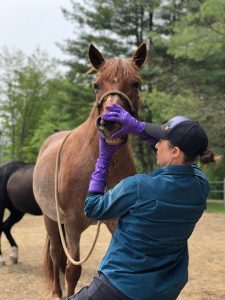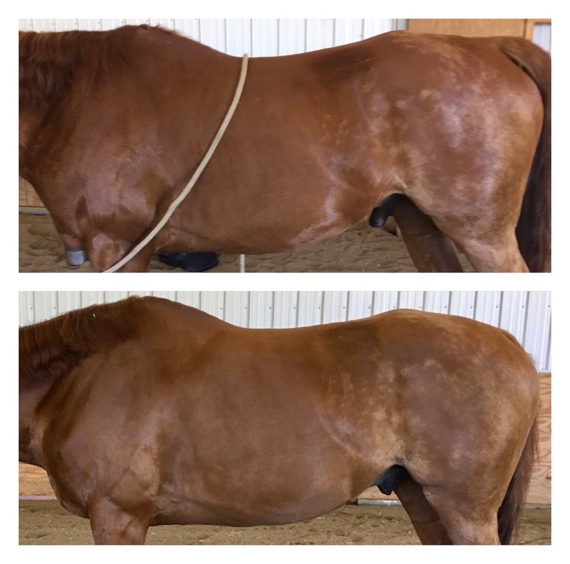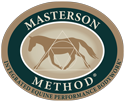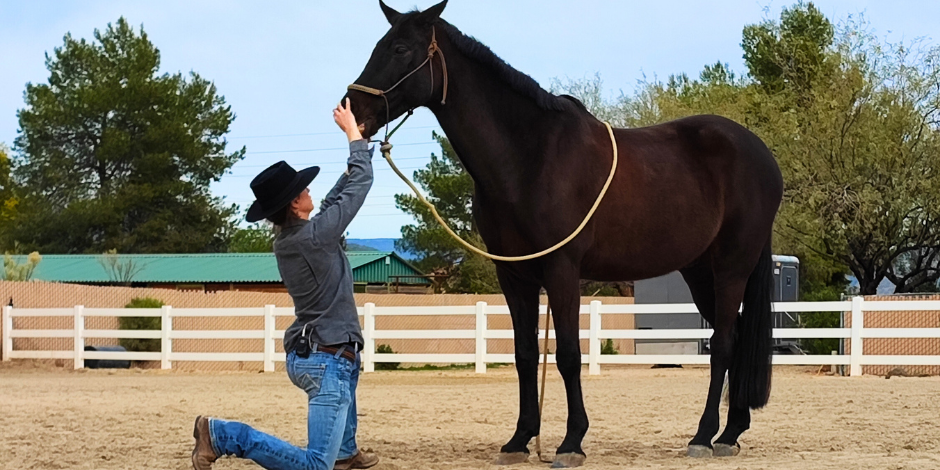by Gretchen Deane
For this month’s Blog Post, we invited Gretchen Deane, MMCP and Certified Neuromuscular Horse Dentist, to share her thoughts on equine dentistry and bodywork.
Did you know that floating practices affect the horse’s whole body and that tension and movement patterns in the horse’s body also affect the teeth?
 Yes, anytime we float a horse’s teeth, we affect posture, neuromuscular health, and movement patterns through the whole body! These days, power floating is mainstream and there is very little information within most educational programs for veterinarians and equine dentists, about the effects of dentistry on the horse’s whole-body wellness, movement, and performance. This means that a very high percentage of horses experience significant imbalances in the teeth, affecting everything from digestion to spinal alignment and the ability to learn and maintain healthy riding postures.
Yes, anytime we float a horse’s teeth, we affect posture, neuromuscular health, and movement patterns through the whole body! These days, power floating is mainstream and there is very little information within most educational programs for veterinarians and equine dentists, about the effects of dentistry on the horse’s whole-body wellness, movement, and performance. This means that a very high percentage of horses experience significant imbalances in the teeth, affecting everything from digestion to spinal alignment and the ability to learn and maintain healthy riding postures.
Spencer LaFlure’s School for Natural Balance Dentistry™/ Neuromuscular Horse Dentistry provides education for equine dental practitioners about angles and composition in the teeth, that can lay the foundation for healthy alignment of the jaw, poll, and neck. Natural Balance / Neuromuscular Horse Dentists also learn to observe and work with natural processing and nervous system regulation of the horse. Many of the responses observed during a dental balance session are the same things we learn to watch and feel for during a Masterson Method® bodywork practice. Making small specific adjustments to the teeth according to the individual horse’s needs, and stepping back many times during a session, allows the horse to adjust gradually, stay relaxed, give feedback, and process changes through the whole body in real-time.
The importance of healthy dental alignment
Horses that have a lot of tension in the jaw, poll, hyoid, and also sacrum and pelvic areas, often have dental imbalances.  These imbalances can originate from dental practices; over-floated cheek teeth with smooth texture, flat angles, and decreased occlusion (surface contact between upper and lower teeth), are some of the most common dental imbalances in today’s industry. Dental imbalances can also be initiated and perpetuated by tension patterns through other parts of the body, especially imbalances within the stomatognathic system. The stomatognathic system includes tissues and structures connected to the horse’s dental system from about the withers forward (brain, muscles, cervical spine, hyoid, etc.), and governs posture and balance through the horse’s whole body. For horses, even changes in the front feet or hooves can quickly alter the way they move and chew through the neck and TMJs, affecting wear patterns in the teeth over time.
These imbalances can originate from dental practices; over-floated cheek teeth with smooth texture, flat angles, and decreased occlusion (surface contact between upper and lower teeth), are some of the most common dental imbalances in today’s industry. Dental imbalances can also be initiated and perpetuated by tension patterns through other parts of the body, especially imbalances within the stomatognathic system. The stomatognathic system includes tissues and structures connected to the horse’s dental system from about the withers forward (brain, muscles, cervical spine, hyoid, etc.), and governs posture and balance through the horse’s whole body. For horses, even changes in the front feet or hooves can quickly alter the way they move and chew through the neck and TMJs, affecting wear patterns in the teeth over time.
Healthy dental alignment that fits the individual horse promotes relaxation and a natural range of motion, especially through the TMJ and poll areas. This leads to much easier bodywork releases through these key junctions! And, as we learn in Masterson Method® practice, tension in the poll means tension through the whole body and very often the sacral area and hind quarters. Effectively releasing the poll junction promotes alignment through the whole spine and healthy functioning of the parasympathetic nervous system.
The parasympathetic nervous system is in action during restoration and relaxation, such as when the horse is eating or at peace with the herd. The sympathetic nervous system (which does not have an R for Relaxation) is the state of fight or flight; usually, not an easy horse to practice bodywork OR dentistry with! But, the Masterson Method® can actually help horses better access parasympathetic states, and Neuromuscular Horse Dentistry can too. Reducing tension in the TMJs and poll can rapidly improve whole-body relaxation for almost any horse, and increase the ability to access that harmonious state on a more regular basis.
Signs in the horse’s body suggesting dental imbalances
Here are some signs in the horse’s body that suggest dental imbalances:
• Decreased muscle development through the topline
• Dished flanks and overdeveloped hamstrings
• Postural extension showing as a pointy croup, hollow back, or ewe neck
• Poll tension, sensitivity around the face, mouth, or ears
• Difficulty with collection, cantering, and lead changes
• Digestive issues such as ulcers and/or sugar-processing issues
 Can you see a difference in this horse’s posture and muscular development, especially through the hind quarters? This horse had both Natural Balance Dentistry™ and follow-up Masterson Method® bodywork over the course of about 6 weeks. No other changes to his living and training program were made.
Can you see a difference in this horse’s posture and muscular development, especially through the hind quarters? This horse had both Natural Balance Dentistry™ and follow-up Masterson Method® bodywork over the course of about 6 weeks. No other changes to his living and training program were made.
Benefits Of Combining Both Methods
The Masterson Method® includes a number of techniques that can help your horse release tension both before and after a dentistry session. Before a Neuromuscular Horse Dentistry session, releasing the neck-shoulder-withers junction can reduce torque through the poll and TMJs, allowing the jaw to fall into a more natural position before adjusting the teeth. TMJ, tongue, hyoid, and poll releases may allow the horse to respond and participate with less reactivity to the dental practitioner and instruments. Following Masterson Method® work, the horse will likely be able to lower the head, open the mouth and move the tongue aside more easily, during a Natural Balance Dentistry™ session. Immediately preceding or within a few days before dentistry, are ideal times for bodywork, but generally, any Masterson Method® work before Natural Balance Dentistry™ can help the horse prepare and integrate.
 After dentistry that is well balanced according to the individual horse, Masterson Method® practice can guide the release of residual, old tension patterns through the body, helping the dental alignment to hold. Anything from TMJ points and head-down poll releases to hind leg releases that affect tension through craniosacral connections, can all help the horse’s teeth stay healthy if the floating practices are also beneficial. When dentistry is balanced for the individual horse, big releases can happen with much greater ease during follow-up Masterson Method® bodywork, and lasting changes often occur within days to weeks through the horse’s whole body. Every horse is different, but many benefit the most from a full Masterson Method® bodywork session 2-4 weeks following dental alignment, or Natural Balance Dentistry™ / Neuromuscular Horse Dentistry.
After dentistry that is well balanced according to the individual horse, Masterson Method® practice can guide the release of residual, old tension patterns through the body, helping the dental alignment to hold. Anything from TMJ points and head-down poll releases to hind leg releases that affect tension through craniosacral connections, can all help the horse’s teeth stay healthy if the floating practices are also beneficial. When dentistry is balanced for the individual horse, big releases can happen with much greater ease during follow-up Masterson Method® bodywork, and lasting changes often occur within days to weeks through the horse’s whole body. Every horse is different, but many benefit the most from a full Masterson Method® bodywork session 2-4 weeks following dental alignment, or Natural Balance Dentistry™ / Neuromuscular Horse Dentistry.
Gretchen Deane:
I began certification for the Masterson Method® in 2015 and quickly discovered that many horses I was working with, had issues in the teeth that affected their participation and processing during bodywork. While I had ridden and trained performance horses professionally for several years at that time, I had no understanding at all about equine dentistry or what it meant, that “the teeth were affecting the body”.
Looking back, some of the horses that struggled most in training were power floated in ways that made it difficult for them to release the jaw, flex and bend, collect, engage the hindquarters, maintain soundness, and even eat. In many areas of the U.S. this was then and is now, mainstream dentistry practice for horses. Practitioners that are performing this type of floating are not made aware of these correlations, so in today’s equine industry, it is largely up to individual owners, riders, and trainers, to seek out information and educated practitioners, for the horses in our care.
If you’ve never heard of Natural Balance Dentistry™ or Neuromuscular Horse Dentistry and would like to learn more or discover a practitioner for your horses, please visit www.neuromuscularhorsedentitry.com or my website at www.gretchendeane.com.
Immerse yourself in The Masterson Method® of equine bodywork with the Beyond Horse Massage book and/or DVD/Online Streaming you will find in the Masterson Method Store. Looking for a hands-on experience? Explore Masterson Method® Courses and find a Seminar near you here Masterson Method Courses. Unleash your potential and deepen your bond with horses!













